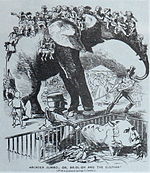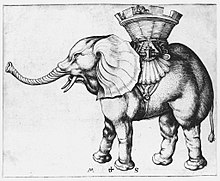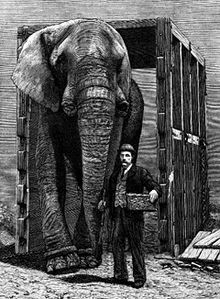Jumbo (elephant)
Jumbo ( [d͡ʒʌmbəʊ] , * around 1860 ; † September 15, 1885 ), called the "King of the Elephants" , was an African bull elephant who became world famous as a crowd puller as a result of intensive press coverage, which was unprecedented for a zoo animal. In 1861 it came from Abyssinia, first to Paris , then to London , where from 1865 to 1882 it was one of the main attractions of the London Zoo . The American showman Phineas Taylor Barnum bought it in 1882 and presented it profitably in the USA in the following years . Jumbo died in 1885 as a result of a collision with a locomotive. Already during his lifetime and after his death he became a legend; his name is synonymous with greatness all over the world .
background
Elephants of African origin are extremely rare in the history of Europe until the 19th century; Jumbo was the fourth to be documented in writing in Europe since the Middle Ages. So Louis IX. of France in 1255 a copy to Henry III. sent to London, which was kept in the menagerie in the Tower until his death . Images from the 15th century, such as a copper engraving by Martin Schongauer (1450–1491), show an elephant whose ears can clearly be identified as an African one. It was a gift from John II of Portugal to Emperor Friedrich III. The contemporary written sources are so contradicting that this animal, which also appears in Koelhoff's chronicle of 1499, must have been part of a herd roaming the German-speaking countries; its various appearances are meanwhile listed as phantoms in literature . In 1668, Louis XIV also received an elephant of African origin , again as a gift from Portugal .
Life
When it was captured in Abyssinia in 1861 , the young elephant was about a year old and about three feet tall; Together with a conspecific he was brought to Paris by the Bavarian collector Johann Schmidt, where he was housed in the Ménagerie du Jardin des Plantes the following year . In 1865, now 125 centimeters high, it was exchanged for a rhinoceros from the London Zoo , where it arrived on June 26 of the same year.
London
In London, Jumbo, which means “hello” (Jambo) in Swahili , was given its name, allegedly from his guard Matthew Scott. In addition to the Obaysch hippopotamus , which has increased visitor numbers since the 1850s, Jumbo developed into another attraction at the London Zoo over the next 16 years. He grew to the impressive height of four meters and had the children ride on his back to the great delight of the audience. It is estimated that during his stay in London he carried over a million children, including Winston Churchill and Theodore Roosevelt , as well as numerous offspring of European aristocratic families. Jumbo became hugely popular in Great Britain due to its considerable press coverage.

When he reached sexual maturity, Jumbo regularly came into a state called musth , which has not yet been fully explored, in which the otherwise peaceful bulls can become unpredictable and even vicious. Jumbo then smashed his stable and let no one near him except his keeper Scott; Even Alice, the elephant who was assigned to him, did not arouse his interest in the least. It was therefore considered too dangerous to continue to let children ride it; the management made it possible to have him shot if necessary.
It was then that the American ringmaster Phineas Taylor Barnum made an offer of $ 10,000 for Jumbo to the management of the London Zoo, an enormous sum at the time that was immediately accepted. This report appeared in the "Times" on January 25, 1882, initially without a great deal of echo. However, when Barnum's men arrived in London on February 27, 1882 to ship the elephant and the press reported it, this time the British nation was indignant that their "darling of the nation" had been sold to America. Well-known public figures, including John Ruskin , initiated a process in which the legality of the trade was to be checked and the Barnum won.
America

On March 24, 1882, Jumbo was shipped on the Assyrian Monarch to New York, where he, accompanied by Matthew Scott, set foot on American soil on April 9, 1882 and was picked up with a brass band; a circus parade took him up Broadway to Madison Square Garden .
The ringmaster Barnum had bought an elephant that could not perform any feats; In contrast to the Asian elephants, African elephants are hardly trainable. Nonetheless, Barnum managed to attract around nine million people in the course of a three-year tour as a traveling menagerie through the USA and Canada with just the presentation of the giant animal .
This tour with the Sangers Royal British Menagerie and Grand International Alliede Shows - Barnum, Bailey and Hutchinson devoured a five-digit dollar sum, especially due to transport costs; Barnum had Jumbo travel with a dwarf elephant named Tom Thumb in a specially constructed "palace carriage". However, since Barnum was well paid for marveling at the giant animal, as was the children's ride, he made a profit of half a million dollars with Jumbo within three years.
On September 15, 1885, Jumbo was caught by the locomotive of an approaching freight train during a reloading action at the station in St. Thomas (Ontario) , apparently due to a switch fault. The locomotive and two other cars derailed; the engine driver and Jumbo were killed.
Afterlife
Barnum had the animal dissected; he donated the skeleton to the American Museum of Natural History in New York. He then bought Alice, a cow elephant, through his London agent, who had been ignored by the cop in London, and had her pose as a “grieving widow” in a walking show with the stuffed jumbo. He donated the Barnum Museum of Natural History , called Barnum Hall , to Tufts College in Medford, Massachusetts, in which Jumbo had been permanently installed since 1889 and became the student's mascot. On April 14, 1975, a fire broke out in Barnum Hall , in which the collection of the preparation burned; What was left was a piece of Jumbo's cock that is still kept at Tufts College to this day.
reception
A hitherto unprecedented hype in the press, both in Great Britain and especially by Barnum in the USA, made Jumbo the “giant pet of two nations” and developed numerous legends during his lifetime. Through Barnum's own publications, which in turn inspired further representations, and not least through Jumbo's presence on the World Wide Web in the 21st century - similar to that of the circus elephant Topsy († 1903) or Mary († 1916) - the origin and change of the various variants Circulating stories largely withdrawn from review.
Legends
The sale of Jumbo in 1882 is reported to have been downplayed by the management of the London Zoo in the face of national indignation; she said they had thought the check with the large sum was a joke. However, there is evidence of a ridiculous poem in which it was suggested that it would be better to sell the Prime Minister than Jumbo. Children would have collected money to buy back the elephant.
When he left for New York, enthusiastic Jumbo fans had given him all kinds of fruit and cake baskets with champagne as provisions as well as whiskey kegs on the ship, since Jumbo allegedly consumed a pail of beer every day, and a gallon of whiskey if he had a cold.
The train accident was due to the fact that Jumbo could not avoid an approaching freight train fast enough. When reloading, he was hindered by wooden walls that were supposed to guide him for the maneuver. This was subsequently enriched by several versions by those present. The station master in St. Thomas said he was so fascinated by the animal that he forgot to switch the switch. Barnum had it spread in the press that Jumbo had saved his friend, the little elephant Tom Thumb, who had carelessly walked onto the tracks, from the train by pushing him off the rails at the last second and found his own death in the process; Jumbo was still alive after the collision and with one last sigh he hugged his guard with his trunk.
At the banquet on the occasion of the handover of the skeleton in New York, a jelly was served which, according to Barnum, had been made with a grated jumbo tusk; the guests present were each allowed to take a small plate of the tusks home with them. The British Museum has one of these souvenirs in its collection.

Fame
“Jumbo, giant pet of two nations”, it is said, “like the popanz Abul Abaz , made himself immortal more than a thousand years before him: In everyday parlance, his name not only stands for elephant per se, but for everything extraordinarily large nevertheless sympathetic. "
Walt Disney gave the king of the elephants wings in a cartoon in 1941: Jumbo rose into the sky as Dumbo with the help of his big ears . Since 1969, the Boeing 747 , an American wide-body aircraft , has been known internationally as a jumbo jet . Walter Höllerer found in 1979 that with Jumbo the USA “finally had a living being big enough for this country”.
literature
- AH Ardmann: Phineas T. Barnum's charming beast. In: Natural history. 82, 1973, pp. 46-50, 55-57.
- Phineas Taylor Barnum: King Humbug. His life, told by himself. (= Construction pocket book . 1725). Berlin 2001, ISBN 3-7466-1725-1 .
- Walter Höllerer : Elephantus Atavus present tense. A variety of foreplay and game about the elephant. In: 1929: Room. 1979, pp. 7-15.
- Stephan Oettermann : The elephant curiosity. An Elephantographia Curiosa. Syndikat, Frankfurt am Main 1982, ISBN 3-8108-0203-4 , p. 184 ff.
- John Sutherland: Jumbo: the Unauthorized Biography of a Victorian Sensation. Aurum Press, London 2014, ISBN 978-1-78131-245-2 .
See also
- Jumbo disambiguation
Web links
- Tufts Journal with the story of the stuffed jumbo
- Tufts Online Magazine: An Elephant's Tale
Individual evidence
- ^ The Cronica van der hilliger Stat va [n] Coelle [n]. Koelhoff 1499, p. 729.
- ↑ See Oettermann (1982) pp. 101-104.
- ↑ Oettermann (1982) pp. 131 and 184.
- ↑ Oettermann (1982) p. 184 f.
- ^ Gerhard Zapff: Jumbo on the wire rope . Henschelverlag, Berlin 1984, p. 12-21 .
- ↑ Alexander Haufellner, Jürgen Schilfarth, Georg Schweiger: Elephants in the zoo and circus: Part 2: North America . Ed .: European Elephant Group. 1997.
- ↑ Ardman (1973) p. 49.
- ↑ Oettermann (1982) p. 188.
- ↑ Oettermann (1982) p. 188; P. 86.
- ↑ Ardman (1973) p. 49.
- ↑ Oettermann (1982) p. 189.
- ↑ Höllerer (1979) p. 12.


